Rodent Control Comprehending Typical Rodent Habits
Rodent Control Comprehending Typical Rodent Habits
Blog Article
Authored By-Payne Alston
When it concerns rodent control, understanding typical rodent habits is essential to successfully taking care of problems. Did you understand that rodents have some interesting nesting routines that might amaze you? By exploring their elaborate behaviors, you can obtain important understandings right into just how to tackle rodent problems in a much more calculated and effective way. So, let's unravel the enigmas behind these creatures' activities and discover how to outmaneuver them in your rodent control initiatives.
Rat Nesting Behaviors
When observing rodents in their natural habitat, you'll see that they actively look for products to construct their nests. Rodents, such as mice and rats, are clever creatures that use a range of items like branches, leaves, paper, and fabric to develop their homes. They're precise in their nest-building procedure, typically lining their nests with softer products like fur or feathers to create a comfortable atmosphere.
Rodents like to build their nests in hidden and safe places to shield themselves and their young from predators. Common nesting areas include wall surface dental caries, attics, cellars, and even within insulation materials. By building their nests in these private locations, rats can securely increase their children far from prospective risks.
It is important to understand the nesting behaviors of rodents when applying control actions. By interrupting their nests or eliminating products, you can prevent rats from developing a presence in your home or residential or commercial property. Proper sanitation and sealing off entry factors are also essential action in avoiding rodent infestations.
Rat Feeding Patterns
After observing rodents' nesting routines, it ends up being obvious that their feeding patterns play a vital function in their day-to-days live and actions. Rodents, including computer mice and rats, are opportunistic feeders, implying they'll take in whatever food source is readily offered. They're largely nocturnal creatures, favoring to forage for food throughout the cover of evening to prevent killers.
Rodents have a varied diet regimen, ranging from grains, seeds, fruits, and veggies to pests, nuts, and even small animals. https://www.theolivepress.es/spain-news/2012/08/02/pest-control-tips-for-a-spanish-summer/ in their food options enables them to thrive in various environments, consisting of metropolitan locations where human food sources are bountiful.
Their feeding patterns aren't just driven by cravings yet additionally by the requirement to accumulate food for times of scarcity. This actions is particularly obvious in preparation for winter season or when nesting. Rodents are recognized to hoard food in their nests or burrows, guaranteeing a continuous food supply. Recognizing their feeding patterns is important in executing efficient rodent control actions to interrupt their food sources and avoid problems.
Rodent Movement and Travel
Rodents navigate their environments with agility and stealth, using their eager detects to move quickly through their atmospheres. These creatures are proficient climbers, able to scale wall surfaces and upright surfaces effortlessly. They can also squeeze via surprisingly little openings, making it important to seal off any possible access factors in your house.
When it pertains to traveling, rats often tend to adhere to acquainted courses, developing tracks along wall surfaces or skirting the sides of rooms. They're creatures of habit, frequently staying with these developed paths as they forage for food or discover their environments.
Rodents are understood for their nighttime habits, so you may hear them hurrying about during the night as they search for food and water. Their movements are quick and irregular, allowing them to dart in and out of view in the blink of an eye.
Comprehending just how rats relocate and take a trip can assist you determine prospective infestation locations in your house and take aggressive actions to stop these bugs from obtaining a foothold.
Verdict
As you function to regulate rats in your home, bear in mind that understanding their habits is crucial. By recognizing https://buckscountyherald.com/stories/dog-prom-raises-money-for-new-wilderz-wildlife-rescue-holiday-house-pet-resort-training-center,17934 nesting practices, feeding patterns, and movement, you can efficiently avoid problems.
Coincidentally, by taking aggressive measures to get rid of food sources and seal off access points, you can disrupt their familiar paths and force them to seek out new locations, ultimately minimizing the likelihood of rodent visibility in your space.
